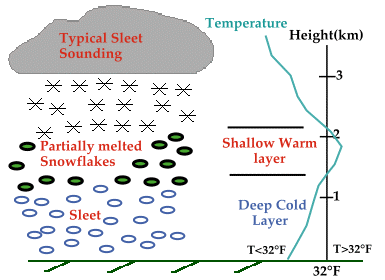|
|
. |
All about Sleet
It's slippery
Sleet is less prevalent than freezing rain and it is defined as
fronzen raindrops that bounce on impact with the ground or other objects.
Sleet is more difficult to forecast than freezing rain because it is
formed under more specialized atmospheric conditions.
It is very similar to freezing rain in that it causes surfaces to become
very slick and causes automobile accidents and falls.
It is also different in that it is not clear as glass and can be easily seen.

For sleet to fall the precipitation must begin as snow.
Once the snow begins to fall it encounters a shallow layer of warm air and
partially melts. The partially melted snow enters the
deep cold layer it refreezes into an ice-pellet and becomes sleet.
|
